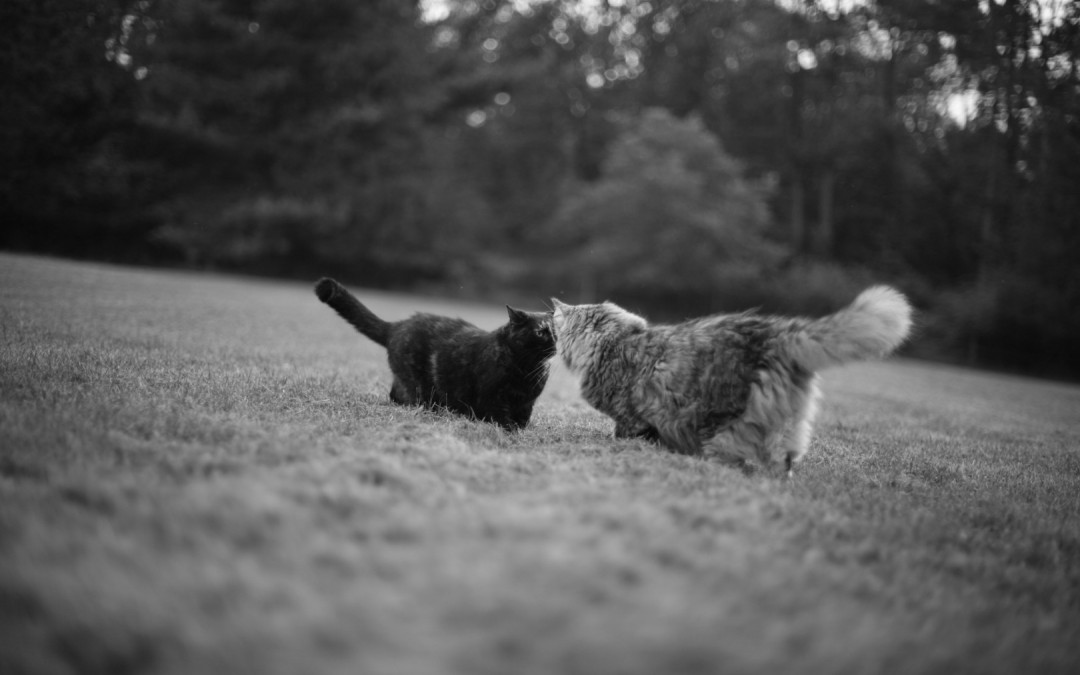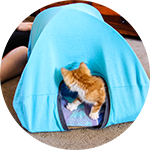
Jan 28, 2016 | DIY & Baking

Quick And Easy DIY Cat Tent With 3 Things You Have At Home
We already know that cats (and kittens) love to sit on things. You put a piece of paper on the floor – and within moments there is a furry cat bum sitting on it. Now that we have foster kittens they also love to steal things like hair clips and hair ties. I’ve been finding them lying around the house in the weirdest spots. With changes in weather sometimes your cat just needs a little privacy. Or a spot that is just their own to relax in and curl up all warm and fuzzy. Here is my Quick And Easy DIY Cat Tent With 3 Things You Have At Home!
Shadow and Frosty (our two adult furr-babies) already have predetermined sleep spots and the foster kitties Ninja and George needed their very own spot. As such I’ve found a whole lot of complicated DIY cat beds on the internet. I wanted something simple and easy. This DIY is so easy to make and will be a purrfect activity for a rainy weekend day. What is even better, is that this easy DIY cat tent uses easy household items that you probably have lying around the house. This activity can be done in about 30 minutes without having to leave the house to buy the supplies you need. It is even easy enough that your non furry babies will be able to do it (and there is no mess to clean up afterwards).
What you will need
- 2 wire coat hangers
- piece of cardboard (approx 15″x 15″)
- an old t-shirt
You will also need some sticky tape, scissors and an old towel or some fabric to line your kitty tent.

Step 1
Cut the cardboard to shape and size. Use masking tape to reinforce the cardboard. You may need to do this if there is a bend in your cardboard.
Step 2
Unwind the wire hangers and stretch them out. With the end of one piece of wire, puncture the corner of the cardboard, pushing the wire through about one to two inches. Bend the wire on the underside of the cardboard to secure it, place a piece of tape over the underside (to cover the sharp end and keep it in place). Do the same with the other end of the same wire, crossing the wire diagonally across the piece of cardboard. Repeat this with the other wire making a ‘dome’ shape.
Step 3
Take your t-shirt and ‘dress’ your wire cat tent frame. The hole where your head goes in the shirt will act as the entrance to the tent, and should sit near the cardboard bottom. Fold the bottom of the shirt underneath the cardboard and secure with safety pins. Keep stretching the shirt so it is taut over the wire frame.
Step 4
You’re done! Place a blanket of some sort in the bottom of the tent to make it cozy and try to tempt your cat inside with catnip. The hard part will be luring them out of their new hidey hole.
Download the printable instructions below.
I would love to see some pictures of the tent you have made – Share them with me on Facebook or Instagram
Meow for now… Kristian

Jan 26, 2016 | Cat Care & Health

Caring For Your Cat: Diet, Food and Nutrition
Caring for your cat’s diet, food and nutrition can be difficult with all the different kinds of food available these days. Good nutrition makes for a healthy, happy cat with a glossy coat and plenty of energy. Newborn kittens, weaning kittens, young cats, adult cats, pregnant and breastfeeding mother cats and old cats all need slightly different diets. In general, all that you need to do is to check that you are buying cat food that offers ‘Complete’ nutrition, and which also is designed for the right age of cat! But, if you want to learn more about the fascinating world of cat nutrition, just read on.
Protein
Cats need protein: it is essential for the growth and repair of their cells as well as for a whole host of other things. That is not the whole story, though: cats also need ‘complete’ protein: proteins which give them all of the amino acids that they need to survive and thrive. One example of such an acid is taurine. In the past, taurine was not known to be an essential food for cats, but now it has been shown to be an important part of cat nutrition it will often be added into cat food.
Complete proteins can only be derived from animals, so you should be extremely warm of feeding your cat vegetarian cat food. If you do want to feed them a vegetarian diet, you will need to pay extra frequent visits to the veterinarian and make sure that they get supplements for taurine and the other amino acids that it is hard for them to get from non animal sources.
Fats and oils
In the right amounts, fats and oils are essential for boosting your cat’s immune system and giving them a lovely glossy coat. Many cat foods seek to replicate the nutrients that cats would get from their ‘natural’ diet (i.e. the diet that cats would ideally get if they were living out in the wild with plentiful prey to hunt). This is certainly the case with the essential fatty acid known as omega 3, which cats can derive from the bodies of herbivorous prey such as mice.
Vitamins and minerals
Just like you, cats need an array of vitamins and minerals: everything ranging from iron to calcium. Vitamins and minerals perform a variety of functions in your cat’s body, such as maintaining a healthy nervous system, enabling blood to clot, and regulating sleep.
Water
A cat’s diet is not all about the solid food you know. Cats need plenty of fresh water available at all times. So make sure to have a bowl of fresh water within reach on every floor of your house, and replenish it daily so it does not go stale.
I live in an old apartment and am worried about rodents. Should I feed my cat a little less to encourage her to catch mice?
Absolutely not! Starving your cat to encourage them to go out is never a good idea as it will deprive your kitty of the essential minerals and other nutrients that she needs. Cats are playful animals and will hunt even when they are not hungry.
Don’t forget to sign up for our newsletter for updates when we publish new articles!
Meow for now … Kristian Taylor
Image Source

Jan 21, 2016 | Cat Care & Health

Unsafe Toys For Your Cat
There is nothing better than seeing your cat happily chasing after its favorite toy, tossing it in the air and then settling down to sleep with it between its paws. Unfortunately, many things that kitties like to play with are actually unsafe for them. Moreover, just because something is on sale in a pet store does not mean that it is necessarily perfectly safe for cats.
So here, without further ado, is an easy guide: know which toys are hurting your cat, three common features that indicate unsafe toys for your cat. So you know what to avoid when you are choosing a gift for your feline companion’s next birthday.
Toys with too much string
We have all seen those kitsch Christmas cards depicting cats playing with balls of yarn by the fireside. And yes, cats will chase pretty much anything involving a lot of string, including your knitting or the cord of your dressing gown.
However, if ingested, yarn can be very dangerous for cats as it can get twisted up in their gut and be very difficult to remove. Many cat toys do have string or yarn-like features to them, such as the cute little tails on little catnip stuffed teddies. But, the golden rule is not to give your cat any toy that has a *long* string attached so there is no danger of them swallowing something that they won’t be able to throw up.
Small toys
Very small toys present a choking hazard to cats, just as they do to human babies. As a rule, do not give your cat anything that they could swallow and get caught in their throat. Though cats can be curious about very small objects such as coins, pen tops and beads left over from your jewelry making class, keep a close eye on them at all times as you do not want curiosity to harm the cat!
Even if the toy itself is relatively large, make sure to give it a quick check to ensure that it does not have any small parts that your cat could chew off and choke on. One example is a pair of googly eyes glued onto a teddy bear. Removing features like these from toys before you give them to your cat is a good idea: your cat does not care what their teddy looks like after all, only about how much potential it has for throwing around in the air, biting on, and snuggling up to.
Large toys that they can get stuck in
From cat baskets with fabric loops securing the bedding to the frame to impromptu toys like plastic bags with handles, toys that have head sized holes in can be hazardous for your cat. If your cat can stick its head through a loop of fabric or a plastic handle, chances are it will do so at some point and the last thing that you want is for its head to then get stuck! So make loops and holes like this safe either by cutting them away or by sewing them firmly down.
Meow for now… Kristian Taylor
Image Source

Jan 19, 2016 | Behaviour & Training

Cat Behaviour 101: Why Cats Like Catnip
Ever wondered why your cat likes catnip? Read on to find out now
Catnip is an herb that belongs to the mint family. Many cats look like they have gone crazy or drugged when they use catnip because they respond to an active ingredient found in it called Nepetalacton. This ingredient is the reason why cats like catnip because it creates a sense of excessive happiness. This chemical makes cats react this way because of an organ found in the cat’s body which is activated by Nepetalacton ingredient. The organ that is affected by the chemical controls all the five organs found in a cat. When catnip leaves are pounded, they release Nepetalacton that most cats react to it differently. Some may act as if they care less but others may go crazy and start jumping around.
Most cats react to catnip by;
- Rolling.
- Flipping.
- Rubbing.
- Zoning out.
- Become Hyperactive.
- Run around.
- Some become very aggressive especially when approached. They feel like they need to protect their toys in this state.
As they react as mentioned above, the cats also meow and growl. The most powerful catnip experience that a cat can have is when it smells the herb and totally goes crazy. However, there is no explanation as to why some cats may react this way because catnip is known to trigger happiness and boost the working of the brain.
Usually after the cat has taken in catnip; the tantrums last about ten minutes before the cat loosens up but it might take up to two hours for him to become reorganized again. However, not all cats respond to catnip, only fifty per cent of cats have been proved to respond to catnip because the reaction is an inherited feeling.
Reaction to catnip is first seen in a cat aged between three to six months. If cats are overdosed with catnip, they can get sick because excessive eating of fresh catnip causes them to vomit and have diarrhea. Cats usually sense when they have had enough of the herb and even though catnip is considered harmless to the cat, if given in excessive amounts, might cause your cat to be unwell.
Other uses of catnip
Catnip is known to be used in training cats to use toys because of how strongly cats react when they take it. This is mostly for indoors cats and it is usually done by sprinkling the herb on a piece of cloth and then putting the toys on the cloth and tying a knot.
However, cats prefer the herb of catnip while fresh and dry than the catnip sprays because they do not contain enough Nepetalacton. Catnip also aids in preventing cats from clawing on furniture. If your cat has a habit of clawing on furniture, all you have to do is rub some of the herb on the place you will prefer it to claw apart from the furniture, e. g the cat’s cushion or bed.
Catnip is not an addictive drug no matter how much you give to your cat over time. However, do not forget that too much of something is poison. Older cats and kittens under three months do not respond to catnip.
Are all your catnip questions answered? If not, what else do you want to know?
Meow for now … Kristian Taylor
Image Source

Jan 14, 2016 | Behaviour & Training, Cat Care & Health

Introducing a New Cat to Your Household
Getting a new cat is always exciting – but introducing a new cat to your household should ideally be a process pervaded by a serene sense of calm. So handle your cat gently and quietly at all times and then if you feel the need to jump up and down and whoop in excitement because you have got a new cat – go and do it out of earshot in the backyard! Households with and without other cats in them will be slightly different environments for a new cat to enter, but here are some simple tips that you can follow when introducing a new cat to your household.
1. Give them space and time
Some new kitties will scramble bravely all over a new household and its inhabitants, checking everything out and doing a preliminary review of its new territory. Others will simply want to run behind the couch and stay there for as long as possible until you entice them out with treats and kindness. It all depends on your cat’s personality. Either way, giving your new kitty their own space and time to get acquainted with their new home is vital.
Kids and adults alike need to be introduced to cats slowly. Do not invade your new cat’s personal space by bounding up to it and grabbing it in a bear hug. Offer it your hand to sniff first, then venture a stroke, then later see if it wants to climb onto your lap…
If you already have cats in your home then it is a good idea to set aside a room as a ‘meeting room’ where the new cat know it can hang out and the old cat knows it can come and pay a visit if it wants to. By doing this, you provide the two cats with a neutral space for bonding in.
2. Make their space progressively bigger
Though they might protest at having to go into their cat boxes whenever it is time for a trip to the veterinarian’s, cats usually find some degree of confinement comforting, as long as the space that they are in feels safe and peaceful. So, one tactic is to start off by confining your kitty to a single quiet room with their own bed and toys and a single kind, gentle human presence. Later, once they know that that room is their base and they can run there whenever they like, you can offer your cat the whole bottom floor of the house to explore, and eventually the whole house and yard if you like.
3. Let them take some toys with them!
If your cat already has some toys and a blanket of its own, it is a very good idea to bring those into your new home and place them in its new cat bed. Cats find comfort in familiar things, and even a very young kitten will usually be able to bring their favorite toy from their previous home. Giving them some toys with catnip in as they arrive, in addition to the items they bring with them, is perfect for cheering a new kitty up!
Leave us a comment with your favourite tips!
Meow for now … Kristian Taylor
Image Source













